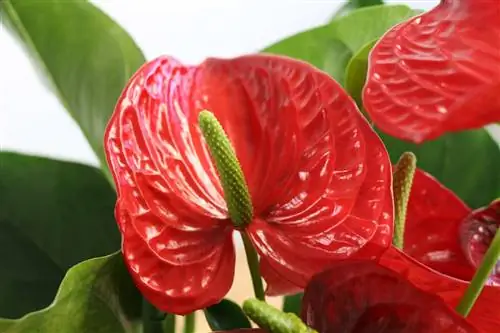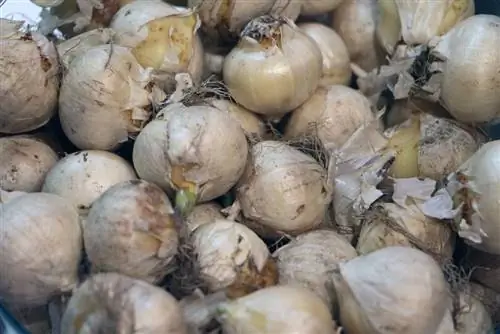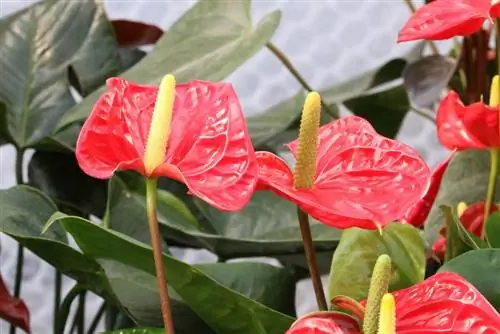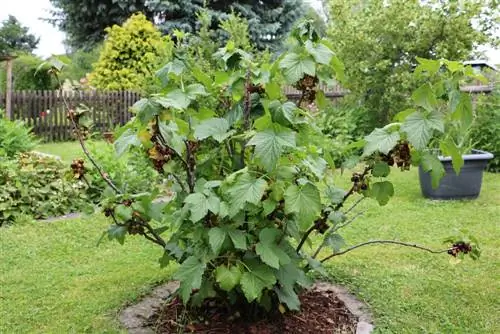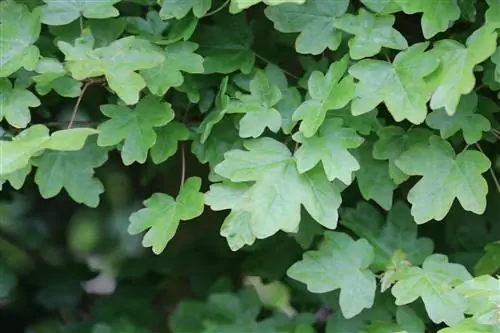- Author admin [email protected].
- Public 2023-12-17 03:39.
- Last modified 2025-01-24 12:45.
Both the leaves and the bright red bracts of the anthurium have long impressed gardeners and flower lovers all over the world. These showy bracts, which form around the inconspicuous yellow spadix, are often mistakenly mistaken for the actual flower.
These fleshy, often waxy-appearing bracts come in many color variations: red, orange, pink, cream, white and green. There are also species that have less impressive bracts. These varieties have particularly extravagant leaves.
Profile
- botanical name: Anthurium
- other names: sulfur flower, candytuft
- belongs to the arum family (Araceae)
- Growth height: between 20 and 100 cm
- Use: ornamental flower plant, houseplant
- Leaves: arrow-shaped, conspicuously colored or solid green depending on the species
- Flower: showy, large bract around a long spadix
- evergreen
- not frost hardy
Species and occurrence
Anthuriums are the most species-rich genus of the arum family. Some species of flamingo flowers, which originally come from South and Central America as well as the Caribbean islands, place quite high demands on their location - especially when it comes to temperature and humidity. The genus also contains a number of less demanding species that can easily be cultivated as houseplants. However, original species are not often found in indoor cultivation; they are usually hybrids. There are three main species cultivated as houseplants:
- Large flamingo flower (Anthurium andraeanum): green, leathery leaves (arrow-shaped), up to 40 cm long, bracts in white, salmon red, bright red and dark red (8-13 cm), flower spadix 6-8 cm in yellow
- Small flamingo flower (Anthurium Schwerzerianum): leathery, dark green leaves (lanceolate), up to 30 cm long, bract bright red (8-10 cm), orange-red, spirally twisted piston
- Anthurium crystallinum: very decorative foliage, leaves heart-shaped with silvery-white veins, up to 55 cm long, inconspicuous inflorescence
Popular varieties of flamingo flower
- Acropolis: creamy white bract
- Princess Alexia Jade: white bract with pink spadix
- Baron: pink
- Picco Bello: pink
- Fantasia: cream colored
- Prince of Orange: bright orange bract
- Midori: green bract
- Pistace: light green
- Rosee Coco: burgundy
Tip:
If you prefer lots of small flowers, you should choose Anthurium andreanum Otazu. This variety produces smaller, reddish-brown bracts.
Location
As residents of tropical regions, anthuriums do not require direct sun to grow and develop their inflorescences. A bright location near the window without direct sunlight is therefore ideal in the apartment. If the flamingo flower is too dark, the leaves become long and thin.
- Light requirements: bright, but no direct sun (midday sun)
- Temperature: constant between 19 and 23 °C during the growth phase
- Humidity: as high as possible
- sensitive to drafts
The ideal location for a flamingo flower is a west or east window. If a curtain or other plants protect the anthurium from the midday sun, a south-facing window is also possible.
Tip:
If the location is too dark, only leaves will form on the flamingo flower, but no flowers.
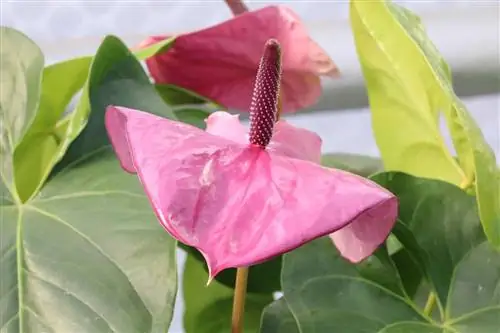
Floor
In their homeland, flamingo flowers grow either on the ground or on trees. They do not develop a pronounced root system. The leaves usually arise directly from the fleshy rootstock. If the anthurium is in a pot, the substrate should be composed as follows:
- high proportion of acidic peat soil
- coarse leaf mold, compost or universal green plant soil
- Sand
- pH value: 4.5-5.5
Watering and fertilizing
During the main growing season, flamingo flowers need to be provided with plenty of water. Your root ball should always be evenly moist. Severe drying out and waterlogging must be avoided at all costs. It is best to water the anthurium with soft water (rainwater) or to immerse the entire root ball in water for a few minutes. Anthuriums are fertilized with a liquid preparation every two weeks during the main growing season (April to August).
Tip:
Anthuriums require relatively high humidity to grow optimally. It is best to spray them regularly with lime-free water.
Repotting
Young plants are transplanted into larger pots in early spring. In older flamingo flowers, the rootstock can also be divided for propagation at this time. An anthurium urgently needs to be repotted if its roots are already growing out of the hole in the pot. Otherwise it is not a problem for the plant if the pot is not very large. A somewhat cramped environment in the root area usually has a beneficial effect on plant growth.
- first fill in a drainage layer
- Material: coarse sand, expanded clay, fine pebbles, lava granules
- the new pot doesn't have to be much bigger than the old one
- Usually a vessel with a diameter of 10 to 18 cm is sufficient
- Grasp the anthurium just above the ground and carefully pull it out of the pot
- shake out old substrate
- remove the top layer of soil (if limescale deposits are visible)
- fill in some fresh substrate
- Insert plant
- fill with soil from all sides
- Every now and then place the pot firmly on the surface
- so the loose substrate sags and no cavities are created
- only insert as deep as before
- Press the soil lightly
- pour generously
All plants that are watered with tap water should also be repotted every two years at the latest. The constant supply of lime through irrigation water causes it to accumulate in the soil, increasing the pH value. If the pH value of the soil is no longer correct, the flamingo flower begins to suffer. Fertilizers are of little help in this situation. Now the plant must be given fresh soil. As much of the old substrate as possible should be carefully removed. The plant does not need a larger pot.
Propagate
Growing an anthurium from seeds is very difficult. Most of the time, no seeds ripen, the seeds germinate poorly or unsightly plants grow. A better way to propagate a flamingo flower is by division. However, this only works with well-developed, older plants. These can be divided when repotting. To do this, the roots of the anthurium are carefully pulled apart. They usually consist of several parts that only need to be separated from each other with a sharp, clean knife. Another way to propagate is to cut off side shoots that are already rooted, which sometimes form on older plants.
Cutting
Only the dried leaves or flower stalks are cut. The flamingo flower does not tolerate radical cuts.
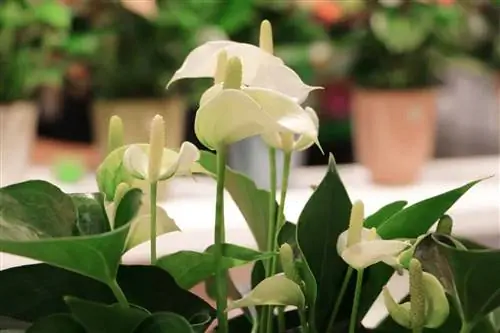
Overwintering/resting phase
A flamingo flower does not actually have to be overwintered. It retains its foliage all year round, but requires a period of rest after the flowering phase to stimulate flower production for the coming growing season. During the winter, an anthurium should therefore be left at temperatures of around 15 °C for six to eight weeks.
- still bright location
- frost-free (stairwell, bright basement room, winter garden)
- water less (only when the soil is already dry)
- do not fertilize
However, the plant should never dry out during the rest phase. At the end of the rest period, anthuriums are watered more heavily and kept warmer. If the plant now begins to sprout vigorously, fertilize regularly again. The most important thing in the winter months is the right humidity. Anthuriums are sensitive to low humidity. While Anthurium scherzerianum and andreanum prefer 55-70% relative humidity, the leafy beauty Anthurium crystallinum only grows optimally when there is at least 60% (better 80%) humidity. This is almost impossible with warm heating air. For them, closed flower windows or winter gardens with appropriate conditions are essential.
Cleaning the leaves
Since a lot of dust tends to collect on the strong, leathery leaves of flamingo flowers, they should be wiped off regularly with a damp sponge. Anthurium crystallinum is also a little more sensitive here. We recommend spraying them with lime-free water to clean the leaves.
Conclusion of the editors
Anthuriums are better known as flamingo flowers. It is an arum plant. The plants bloom profusely between February and May, but flowers also appear more often. The varieties anthurium scherzerianum and anthurium andreanum are particularly suitable as houseplants. Anthuriums look good in closed flower windows.
What you should know about the anthurium in brief
Toxicity
- The leaves of some species contain toxins. The concentrations of toxic components fluctuate.
- Consumption can cause gastrointestinal problems, nausea, diarrhea and vomiting can occur.
- Contact with the skin or mucous membranes can cause redness, blistering or increased salivation.
- If poisoning is suspected, you should drink plenty of fluids.
Location and temperatures
- Anthuriums like it very bright, but must be protected from direct sunlight. West windows are ideal.
- They love warmth (around 20 °C) and need high humidity.
- They can stay in a warm room all year round, but need to be sprayed more often, especially in winter.
- Be careful not to spray on the bracts. Only use warm, soft water.
- The room temperatures should not fluctuate if possible.
Winter rest
- For about 6 weeks a year, in December/January, when the new buds form, the anthurium needs a cooler place.
- 15 °C is then sufficient. At temperatures above 20 °C, hardly any flowers form.
- The plant must be protected from drafts, it cannot tolerate it at all.
Watering and fertilizing
- Anthuriums need enough water. It should be descaled and lukewarm. Rainwater is ideal.
- The soil should always be slightly moist. During the short rest period, watering is carried out very sparingly and no fertilization is used.
- Otherwise, fertilize every 14 days between April and September. The plants don't like waterlogging, which usually leads to root rot.
Repotting
- When the plant's roots grow out of the pot, it's time to repot it.
- The best time for this is spring.
Planting substrate
- Soil with polystyrene flakes mixed in is suitable as a planting substrate.
- You can also mix charcoal, leaf mold, sand and peat and make your own planting substrate.
- Under no circumstances should the soil be calcareous.
- Anthuriums are very suitable for hydroponics.
Propagation
- The easiest way to propagate is to divide the plant when repotting.
- Rooted side shoots can also be easily separated.
- You can moss off the tips of the shoots of the large flamingo flower.
- Stem and head cuttings are also possible.
Tip:
Anthuriums cope well with warm feet, which means they look good on the window frame above a radiator and also with underfloor heating. To be on the safe side, you should put a thick cork coaster underneath. You also have to be very careful that the soil doesn't dry out.
Brown or yellow leaves
- It often happens that the tips of the leaves turn yellow-brown. This is usually due to water that is too hard or in a location that is too cool.
- Dried leaf edges are usually a sign that the air is too dry.

